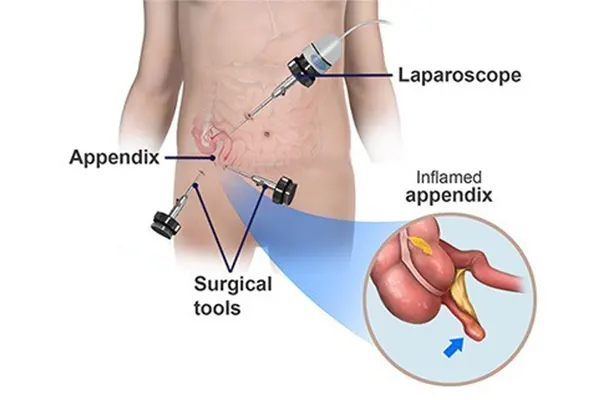What is Laparoscopic Appendectomy?
Laparoscopic appendectomy is a minimally invasive surgical procedure performed to remove an inflamed or infected appendix, a condition known as appendicitis. Unlike traditional open surgery, laparoscopic appendectomy uses small incisions and a laparoscope (a thin tube with a camera) to guide the surgeon in safely removing the appendix. This method results in faster recovery, less pain, and minimal scarring for the patient.Laparoscopic appendectomy is a safe, effective, and modern surgical treatment for appendicitis, offering patients a faster and more comfortable recovery with minimal scarring. If you experience symptoms of appendicitis, consult a surgeon immediately to avoid complications like rupture or peritonitis.

Symptoms of Appendicitis
Common symptoms that may require a laparoscopic appendectomy include:
- Sudden pain in the lower right abdomen
- Pain that worsens with movement, coughing, or deep breathing
- Nausea and vomiting
- Loss of appetite
- Abdominal swelling
- Low-grade fever
- Constipation or diarrhoea
If these symptoms persist or worsen, it is crucial to seek immediate medical attention to prevent rupture of the appendix.
Procedure or Treatment
Laparoscopic appendectomy procedure involves:
- Anaesthesia: The patient is given general anaesthesia for a pain-free surgery.
- Small Incisions: 2-3 small incisions are made in the abdomen.
- Insertion of Laparoscope: A laparoscope connected to a camera is inserted to provide a clear view of the appendix.
- Removal: Surgical instruments are inserted through other incisions to remove the inflamed appendix.
- Closure: The incisions are closed with sutures or surgical glue.
The procedure usually takes 30-60 minutes, and patients can often go home within a day, depending on their condition and recovery.
Prevention
There is no guaranteed way to prevent appendicitis; however, maintaining a diet high in fibre with fresh fruits, vegetables, and whole grains may reduce the risk by preventing constipation and promoting gut health.
Benefits of Laparoscopic Appendectomy
- Minimally invasive: Smaller incisions and reduced trauma to abdominal tissues
- Faster recovery: Shorter hospital stay and quicker return to normal activities
- Less pain: Reduced postoperative pain compared to open surgery
- Lower risk of infection: Smaller wounds mean fewer chances of wound infections
- Minimal scarring: Tiny incisions lead to better cosmetic results
Types of Appendectomy
Laparoscopic Appendectomy: Performed through small keyhole incisions with the help of a laparoscope; preferred for quicker recovery and less postoperative discomfort.
Open Appendectomy: Traditional method where a single larger incision is made in the lower right abdomen; used in complicated cases such as ruptured appendix or widespread infection.
